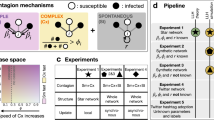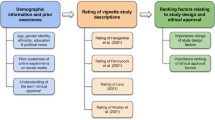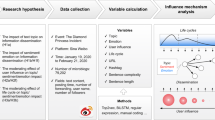Abstract
The ubiquity of social media use and the digital data traces it produces has triggered a potential methodological shift in the psychological sciences away from traditional, laboratory-based experimentation. The hope is that, by using computational social science methods to analyse large-scale observational data from social media, human behaviour can be studied with greater statistical power and ecological validity. However, current standards of null hypothesis significance testing and correlational statistics seem ill-suited to markedly noisy, high-dimensional social media datasets. We explore this point by probing the moral contagion phenomenon, whereby the use of moral-emotional language increases the probability of message spread. Through out-of-sample prediction, model comparisons and specification curve analyses, we find that the moral contagion model performs no better than an implausible XYZ contagion model. This highlights the risks of using purely correlational evidence from large observational datasets and sounds a cautionary note for psychology’s merge with big data.
This is a preview of subscription content, access via your institution
Access options
Access Nature and 54 other Nature Portfolio journals
Get Nature+, our best-value online-access subscription
$32.99 / 30 days
cancel any time
Subscribe to this journal
Receive 12 digital issues and online access to articles
$119.00 per year
only $9.92 per issue
Buy this article
- Purchase on SpringerLink
- Instant access to full article PDF
Prices may be subject to local taxes which are calculated during checkout


Similar content being viewed by others
Data availability
The data files analysed in this study are publicly available. For the COVID-19 and #MuellerReport corpora, which were specifically collected for this study, the tweet IDs have been made available on OSF, but not the tweet text due to restrictions set by Twitter. To access the pre-existing corpora, see refs. 19,20,21,22, or follow the links from the OSF project page directing to the original hosting sites (https://osf.io/4zjk6/).
Code availability
All scripts used for the analyses presented in this article are available on the OSF project page (https://osf.io/4zjk6/).
References
Tufekci, Z. Twitter and Tear Gas: The Power and Fragility of Networked Protest (Yale Univ. Press, 2017).
Sunstein, C. R. #Republic: Divided Democracy in the Age of Social Media (Princeton Univ. Press, 2018).
Moore, M. Democracy Hacked: Political Turmoil and Information Warfare in the Digital Age (Oneworld, 2019).
Lazer, D. et al. Computational social science. Science 323, 721–723 (2009).
Giles, J. Making the links. Nature 488, 448–450 (2012).
Conte, R. et al. Manifesto of computational social science. Eur. Phys. J. Spec. Top. 214, 325–346 (2012).
Edelmann, A., Wolff, T., Montagne, D. & Bail, C. A. Computational social science and sociology. Annu. Rev. Sociol. 46, 61–81 (2020).
Brady, W. J., Wills, J. A., Jost, J. T., Tucker, J. A. & Van Bavel, J. J. Emotion shapes the diffusion of moralized content in social networks. Proc. Natl Acad. Sci. USA 114, 7313–7318 (2017).
Crockett, M. J. Moral outrage in the digital age. Nat. Hum. Behav. 1, 769–771 (2017).
Ben-Nun Bloom, P. & Levitan, L. C. We’re closer than I thought: social network heterogeneity, morality, and political persuasion. Polit. Psychol. 32, 643–665 (2011).
De Choudhury, M., Counts, S. & Horvitz, E. in Proceedings of the SIGCHI Conference on Human Factors in Computing Systems 3267–3276 (ACM, 2013).
Tumasjan, A., Sprenger, T. O., Sander, P. G. & Welpe, I. M. in Proceedings of the Fourth International AAAI Conference on Weblogs and Social Media 178–185 (AAAI, 2010).
Garcia, D. & Rimé, B. Collective emotions and social resilience in the digital traces after a terrorist attack. Psychol. Sci. 30, 617–628 (2019).
Salganik, M. Bit by Bit: Social Research in the Digital Age (Princeton Univ. Press, 2017).
Tufekci, Z. in Proceedings of the Eighth International AAAI Conference on Weblogs and Social Media 505–514 (AAAI, 2014).
Ruths, D. & Pfeffer, J. Social media for large studies of behavior. Science 346, 1063–1064 (2014).
Simmons, J. P., Nelson, L. D. & Simonsohn, U. False-positive psychology: undisclosed flexibility in data collection and analysis allows presenting anything as significant. Psychol. Sci. 22, 1359–1366 (2011).
Hodas, N. O. & Lerman, K. The simple rules of social contagion. Sci. Rep. 4, 4343 (2014).
Turner, A. 390,000 #MeToo Tweets. data.world (2018); https://data.world/balexturner/390-000-metoo-tweets
Adhokshaja, P. #Inauguration and #WomensMarch. Kaggle (2017); https://www.kaggle.com/adhok93/inauguration-and-womensmarch-tweets
Parker, C. Brexit Tweets from the morning of its announcement. Mendeley Data (2017); https://data.mendeley.com/datasets/x9wkrghz23/2
Amador, J., Oehmichen, A. & Molina-Solana, M. Fakenews on 2016 US elections viral tweets (November 2016 – March 2017). Zenodo (2017); https://zenodo.org/record/1048826#.X9s59C2l10s
Shalizi, C. R. & Thomas, A. C. Homophily and contagion are generically confounded in observational social network studies. Sociol. Methods Res. 40, 211–239 (2011).
Aral, S., Muchnik, L. & Sundararajan, A. Distinguishing influence-based contagion from homophily-driven diffusion in dynamic networks. Proc. Natl Acad. Sci. U. S. A. 106, 21544–21549 (2009).
Hilbig, B. E. Reconsidering ‘evidence’ for fast-and-frugal heuristics. Psychon. Bull. Rev. 17, 923–930 (2010).
Suh, B., Hong, L., Pirolli, P. & Chi, E. H. in 2010 IEEE Second International Conference on Social Computing 177–184 (IEEE, 2010).
Lazer, D. M. J. et al. The science of fake news. Science 359, 1094–1096 (2018).
Kollanyi, B., Howard, P. N. & Woolley, S. C. Bots and automation over Twitter during the U.S. election. Information Geographies http://geography.oii.ox.ac.uk/wp-content/uploads/sites/89/2016/11/Data-Memo-US-Election.pdf (Univ. Oxford, 2016).
Stieglitz, S. & Dang-Xuan, L. Emotions and information diffusion in social media—sentiment of microblogs and sharing behavior. J. Manag. Inf. Syst. 29, 217–248 (2013).
Ferrara, E. & Yang, Z. Quantifying the effect of sentiment on information diffusion in social media. PeerJ Comput. Sci. 1, e26 (2015).
Simonsohn, U., Simmons, J. P. & Nelson, L. D. Specification curve analysis. Nat. Hum. Behav. 4, 1208–1214 (2020).
Gelman, A. & Loken, E. The statistical crisis in science. Am. Sci. 102, 460–466 (2014).
Steegen, S., Tuerlinckx, F., Gelman, A. & Vanpaemel, W. Increasing transparency through a multiverse analysis. Perspect. Psychol. Sci. 11, 702–712 (2016).
Brady, W. J., Gantman, A. P. & Van Bavel, J. J. Attentional capture helps explain why moral and emotional content go viral. J. Exp. Psychol. Gen. 149, 746–756 (2020).
Rohrer, J. M. Thinking clearly about correlations and causation: graphical causal models for observational data. Adv. Methods Pract. Psychol. Sci. 1, 27–42 (2018).
Mooijman, M., Hoover, J., Lin, Y., Ji, H. & Dehghani, M. Moralization in social networks and the emergence of violence during protests. Nat. Hum. Behav. 2, 389–396 (2018).
Dehghani, M. et al. Purity homophily in social networks. J. Exp. Psychol. Gen. 145, 366–375 (2016).
Westfall, J. & Yarkoni, T. Statistically controlling for confounding constructs is harder than you think. PLoS ONE 11, e0152719 (2016).
Denny, M. & Spirling, A. Text preprocessing for unsupervised learning: why it matters, when it misleads, and what to do about it. Polit. Anal. 26, 168–189 (2018).
Hoover, J. et al. Moral foundations Twitter corpus: a collection of 35k tweets annotated for moral sentiment. Soc. Psychol. Personal. Sci. 11, 1057–1071 (2019).
Cohen-Cole, E. & Fletcher, J. M. Detecting implausible social network effects in acne, height, and headaches: longitudinal analysis. Br. Med. J. 337, a2533–a2533 (2008).
Kearney, M. W. rtweet: Collecting and analyzing Twitter data. J. Open Source Soft. 4, 1829 (2019).
Hilbe, J. M. Negative Binomial Regression (Cambridge Univ. Press, 2011).
Wagenmakers, E.-J. & Farrell, S. AIC model selection using Akaike weights. Psychon. Bull. Rev. 11, 192–196 (2004).
Masur, P. K. & Sharkow, M. specr: Statistical functions for conducting specification curve analyses (version 0.2.1) (2019); https://CRAN.R-project.org/package=specr
Acknowledgements
The authors received no specific funding for this work and thank the Causal Cognition Lab at University College London for their helpful feedback on this work.
Author information
Authors and Affiliations
Contributions
J.W.B. and U.H. designed the research. J.W.B. and N.C. analysed the data. J.W.B wrote the paper, and all authors contributed to revisions.
Corresponding author
Ethics declarations
Competing interests
The authors declare no competing interests.
Additional information
Peer review information Nature Human Behaviour thanks Morteza Dehghani and the other, anonymous, reviewer(s) for their contribution to the peer review of this work. The editors also thank William Brady and Jay Van Bavel for providing signed comments.
Publisher’s note Springer Nature remains neutral with regard to jurisdictional claims in published maps and institutional affiliations.
Supplementary information
Supplementary information
Supplementary Methods, Supplementary Results, Supplementary Tables 1–3, Supplementary Figs. 1–9 and Supplementary References.
Rights and permissions
About this article
Cite this article
Burton, J.W., Cruz, N. & Hahn, U. Reconsidering evidence of moral contagion in online social networks. Nat Hum Behav 5, 1629–1635 (2021). https://doi.org/10.1038/s41562-021-01133-5
Received:
Accepted:
Published:
Issue date:
DOI: https://doi.org/10.1038/s41562-021-01133-5
This article is cited by
-
Using natural language processing to analyse text data in behavioural science
Nature Reviews Psychology (2025)
-
Promote to protect: data-driven computational model of peer influence for vaccine perception
Scientific Reports (2024)
-
Changes in Online Moral Discourse About Public Figures During #MeToo
Affective Science (2024)
-
Theory and methods of the multiverse: an application for panel-based models
Quality & Quantity (2024)
-
Morality and partisan social media engagement: a natural language examination of moral political messaging and engagement during the 2018 US midterm elections
Journal of Computational Social Science (2024)



